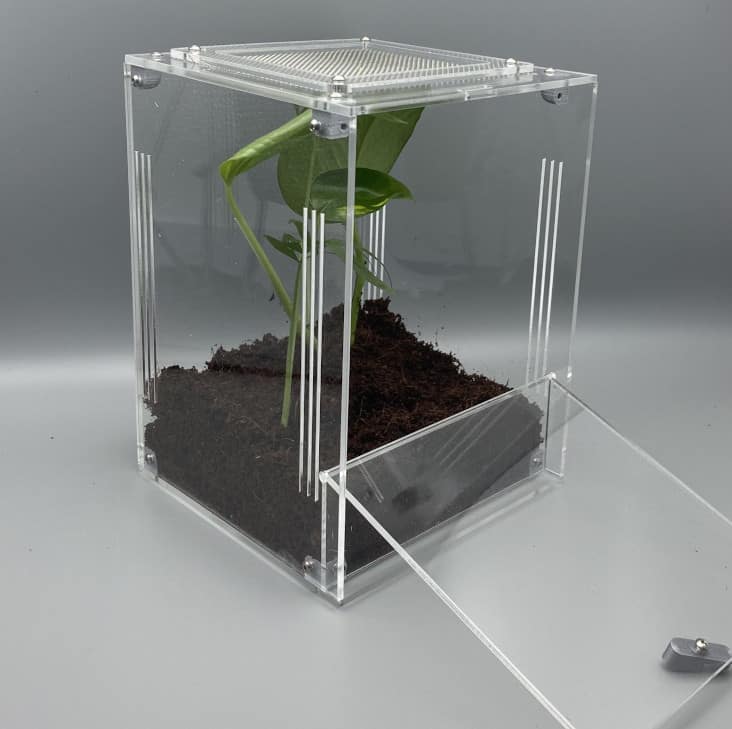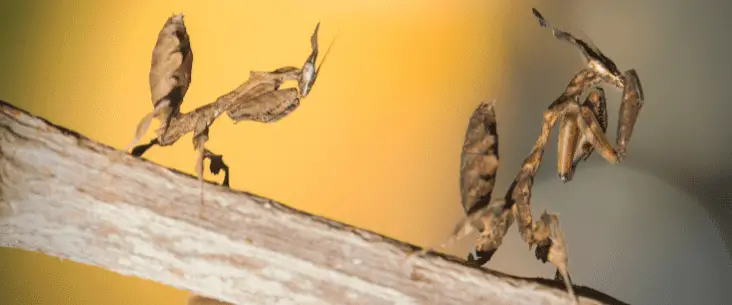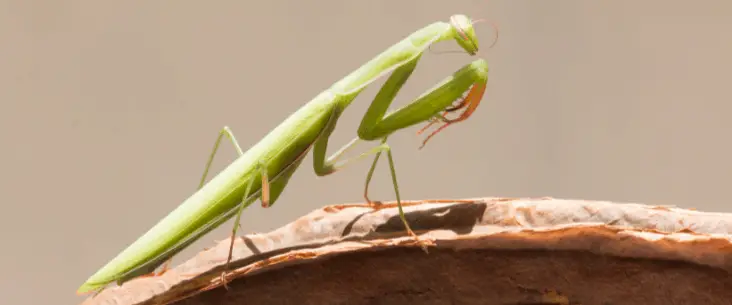A praying mantis enclosure is rather easy to set up. Mantises are great pets because they are easy to keep and don’t have high requirements. But, you still need to think of some essentials to keep your praying mantis happy and healthy. If your praying mantis has an enclosure that is not suitable, you get all kinds of problems later on. Setting up your praying mantis enclosure is one of those things you just want to have right from the start.
Although it is not difficult to set up a good environment for your praying mantis, you need to make some crucial choices, and there are some basic things to think about. With this easy checklist, we discuss how you can quickly set up an enclosure the right way in 7 easy steps.
Recommended read: Basics of keeping praying mantis
There is much to learn about keeping a praying mantis! If you want to know more about their care, I recommend reading our basics guide on how to care for your praying mantis. It is packed with practical tips and all the knowledge you need to start keeping a praying mantis successfully.
#1 Research your praying mantis species
How you set up your enclosure mainly depends on the species you like to keep. There is not a ‘one-size-fits-all’ solution. Therefore, you need to do some research onto your praying mantis. What is the natural habitat it is living in, what temperature and humidity do they like, how does it feed and do they live solitary or communal?
For example, the size of the praying mantis decides how large your enclosure needs to be. It is important to understand your species better before you buy one. Only then you can give it the best possible care.
There is a lot of information out there on the internet and in books. You can start searching on this website, but don’t limit only to that. Try to find more information on your species to make better choices on how you should keep your praying mantis.
#2 Choose between natural and practical setup
You don’t have to keep them in a natural setup. For example, it does not matter for the animal if you keep them on newspaper ‘substrate’ or use white sand as a substrate. However, if you have a praying mantis that likes a humid environment, coconut fibre is much more suitable.
But even if natural material is not necessary, maybe you like the look of a beautifully designed enclosure. Some keep praying mantis to breed with them, but others will have the enclosure as a centrepiece in their living room.
You have to decide upfront if you like a practical or natural setup. But besides how it looks, what is the difference then? Well, a practical setup makes the care more easy and practical (and often a bit cheaper). You think about ways to make the cleaning and feeding easier. With a natural setup, you try to mimic the natural habitat in some way, to make it look more beautiful.
Of course, you can change it during your mantis pet’s life, but it is much easier to choose it now before you set up your enclosure.
Items you will need:
#3 Pick a suitable enclosure (type and size)
Probably the biggest investment is a good terrarium. You can house praying mantis in cheaper options like plastic faunariums and containers, but it does not look half as good (and if esthetics matter…)
The enclosure is the fundament of keeping a praying mantis. It is the backbone where all other items are added to create the perfect environments. There are two main things you need to consider: The size and the type of the enclosure.
What enclosure size does my praying mantis need?
Enclosure size is depended on the size of your praying mantis. The simple rule is that your enclosure needs to be three times the adult body length in width, and two times the body length deep.
The height is also important for mantises. The height of the enclosure needs to be at least three times the body length to be able to moult properly. They do that by hanging upsidedown on a branch or the lid and let them slide out of their old skin.
If you have a praying mantis of 10cm (4″), the enclosure needs to be at least 30cm wide, 20cm deep, and 30cm high (12″ x 8″ x12″). This is measured for single housed species. If you want praying mantis species (e.g. wandering violin mantis) that can live communally, you need a much larger enclosure.

What type of enclosure should I choose?
We already mentioned it: you can different types of enclosures. A terrarium like the ones of Exo Terra or ZooMed is very suitable for keeping a praying mantis, but you can also house them in a faunarium or plastic container.
Terrariums generally have all the features you need for keeping mantises (e.g. proper ventilation). Other types of enclosures often need to be adjusted to make them suitable. But, on the other hand, they are often much cheaper than a terrarium.
There are many ways to keep praying mantises properly. For example, one person has refurbished a small greenhouse terrarium to use as an enclosure for praying mantises.
When you search for a suitable enclosure, the enclosure needs to have at least these features:
- The height is evenly important as width, so a vertical enclosure is best suitable.
- Preferably the lid of the enclosure is made out of fine wire mesh.
- It should have good ventilation (mesh lid or ventilation grilles).
- Can be closed tidely (without gaps and openings), so the mantis can’t escape.
Features that can come in handy:
- Access from the top and front for easy feeding and cleaning.
- A solid bottom plate to have substrate on the floor.
- Side and top ventilation so there is airflow.
The location of the enclosure
Besides what kind of enclosure you take, it is also about where you should place the enclosure. The location of the enclosure is rather important for the well-being of your pet praying mantis.
One of the biggest mistakes is to place the enclosure in direct sunlight. Because it is an enclosed space (even with plenty of ventilation), the temperature will rise rather quickly to temperatures that are deadly to your animal. Always place the enclosure away from windows where sunlight will shine directly on it.
But you also need to consider other factors that can disturb your praying mantis. Small vibration for us can be huge stressors for small insects. Don’t place the enclosure near a location where music, hard sounds or running children disturbing your pet animal(s).
Also, consider your other pets. Birds and cats are sometimes obsessed with little insects and can try to hunt them. If they are smart enough to open the enclosure, it may be the end for your mantis. I recently heard a case that a dog knocked over a terrarium and harmed the pet insect living in it. You probably do not want to experience such an event. So, have a good thought about where you want to place your enclosure.
Good Practice Tip: When you bought a new enclosure, or when you use an old enclosure where another animal has lived in, it would be best to clean the enclosure with water and a soap-free sponge thoroughly. Do not use soap or chemicals, because praying mantises (like other insects) are sensitive to these chemicals.
#4 Choose a substrate (or choose non)
First of all, a substrate is not explicitly necessary for keeping praying mantises. The mantis itself doesn’t need it to burrow in, search for food or to lay eggs. However, there are two reasons you may want to consider to use a substrate.
The first reason is to increase and maintain a humid environment (see also step 6). A substrate creates a buffer by absorbing water and slowly release it into the air. For species that require higher humidity levels, it is highly recommended to use a substrate. Suitable substrates are coconut fibre, (white) sand, earth, and vermiculite. A 2cm (0.8″) layer is already enough
If you like a more practical setup, you can also use paper kitchen towels or dishcloths as a substrate. These are easier to clean or to refresh and make cleaning the enclosure less time-consuming. However, it doesn’t look that nice.
The other reason to use a substrate is to create a more natural look of the enclosure. The substrate is the basis where you can add live plants, mosses, wood pieces and rocks so that the enclosure will be better-looking and more attractive to show in your living room.

#5 Furnishing and decorate the enclosure
When you have an enclosure and decide whether you place a substrate or not, it is time to furnish and decorate the enclosure.
First, there are some necessary attributes you should add to your enclosure. Climbing structure and opportunities for praying mantis to hang on are a necessity to keep praying mantis healthy. Mantises live on branches and plants, and will rarely walk on the bottom. Add enough branches, twigs and other climbing structure to your enclosure, but try to keep the bottom accessible for cleaning.
When you have a substrate, you can also add live plants. Otherwise, you could also add artificial plants. Not only make this you enclosure more visually pleasing, but it also provides your praying mantis places to hide. They will be much happier when they sometimes can get out of sight.
Other decorations that can be added are mosses, rocks and pebbles, pieces of wood, and a decorated background. For the background, you can use cork plates. When you want to add a background, do that before adding the substrate and other items in the enclosure.
#6 Create and maintain correct temperature and humidity
Every praying mantis species has an optimal temperature and humidity range where they will thrive. Generally, most praying mantis can be kept at room temperature or a bit higher around 20°C and 23°C (68°F-73°F). However, some mantises like it really hot.
When your enclosure doesn’t meet the temperature requirements, you should place a regular light bulb above or low wattage heating pad under the enclosure. Best would be to use a timed switch to switch on the light or heating pad only during the daytime. It would be best to experiment with which wattage light or heating pad suits your situation because it depends on the animal’s needs, the enclosure’s size, the ambient temperature, and the ventilation capacity.
The humidity is more fluctuating between species. Some species, like the wandering violin mantis, like it to have it really dry. Others will prefer a much more humid environment. We already discussed that a substrate would contribute to maintaining a proper humidity level. However, you also need to mist spray water regularly into the enclosure to keep the environment moist. Please don’t make it too wet, but spray some water onto or into the enclosure when you see it becomes dry.
Although some mantises like it dry, it does not mean you never have to spray water. When spraying water, the mantis will drink the water drops off the glass and branches. It can even lead to moulting problems if the environment is too dry. But do not overdo it. Spraying once a week or every other week will work with these species.
Good Practice Tip: Only use a new spray bottle or a spray bottle that is never used for anything else but spraying water. Many chemicals or pesticides, even in tiny amounts, can be deadly to your praying mantis. When you bought a new spray bottle, rinse it with water first before using it. Never spray water directly on the animal.
#7 Introduce your praying mantis
Now your enclosure is ready to introduce your praying mantis into its new home. If you have followed all steps, your enclosure is ready to provide a healthy environment and fulfil all their needs.
When your praying mantis arrives, place them carefully into the enclosure. Don’t pick it up, but let it walk on his own. It is not a problem to give it a little nudge when it doesn’t come out, but don’t rush it. It can be quite stressful for a praying mantis, and it takes time for them to get used to its new environment. When it fits, you can also place the transport box into the enclosure so the animal itself can decide when it is time to come out.
It can happen that your praying mantis will not eat immediately because it is busy discovering its new home. Just let it be, and start feeding the next day. It is time for you to enjoy your new pet. Observe and enjoy its hunting skills and other interesting behaviours. When you are ready, you may want to think about breeding with them.
Want to know more?
There is much more to learn about keeping praying mantises as a pet. Check out all our articles about praying mantises to learn how to keep, care and breed praying mantises. For example, here you can read what the best feeding practice is for your praying mantis.
Share this page!



